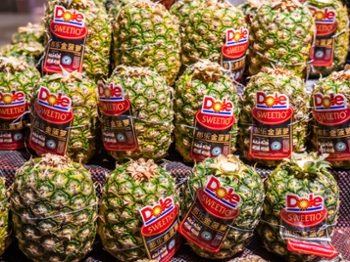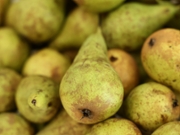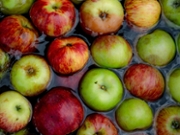| Global news for the produce and floral industry | SIGN UP ⋅ SHARE |
|
|
 
|
Global Connections
| |
 |
| (SOPA Images/Getty Images) |
Dole's new Colada Royale Pineapple, a variety specifically designed to capture the essence of a piña colada, will start being stocked at grocery stores this month. Developed over more than 15 years by Dr. Roberto Young at Dole's largest Latin American farm, the fruit features a blend of tangy sweetness with subtle notes of coconut and vanilla, setting it apart from traditional pineapples, and its smaller core increases the amount of edible fruit.
|
|
| |
 |
| (NurPhoto/Getty Images) |
Despite their nutrient density and versatility, pears are often overlooked in the produce section, making them one of the most underrated fruits available. Although pears offer a variety of health benefits, including fiber for digestion, hydration, antioxidants and key nutrients, they have yet to achieve widespread popularity, particularly among younger consumers. This lack of recognition represents both a challenge and a significant opportunity for the industry to elevate pears' status in the marketplace, says Trisha Casper of Superfresh Growers. "Pears already have a loyal and diverse base among the older generations but winning younger shoppers will define the future of the category," Casper says.
|
|
|
Fruits and vegetables expected to be popular among shoppers this fall and winter include organic sweet potatoes and winter squash, as well as more exotic items such as lychee and goldenberries, industry experts say. "Beyond classic orange sweet potatoes, we're seeing strong curiosity for Japanese sweet potatoes and white sweet potatoes, which roast up with a caramelized exterior and creamy interior," says Carl DelPrete, CEO of Uncle Giuseppe's Marketplace in Melville, N.Y. The experts also note the rise of demand for organic and locally sourced produce and functional superfoods, such as antioxidant-rich berries.
|
|
| |
 |
| (MediaNews Group/The Riverside Press-Enterprise Via Getty Images/Getty Images) |
After years of pumpkin spice dominating fall menus, consumer fatigue is setting in. According to a Rubix Foods survey, 47% of respondents now view pumpkin spice as overrated, and 25% say they are completely over pumpkin-flavored items. Apple flavors, meanwhile, are quickly rising in popularity as fall beverage choices. The survey reports that apple butter is now the top fall flavor consumers want to see on menus, with apple cider and spiced apple also ranking highly. Industry analysts note that apple's tangy, spiced profile and association with comfort and nostalgia make it well-suited to the fall season.
|
|
|
Africa's Vegetable Genebank has deposited over 3,000 seed samples from 109 crop species into the Svalbard Global Seed Vault, marking the first major backup of African opportunity crops in the Arctic facility. The collection includes essential traditional vegetables such as amaranth, jute mallow and Bambara groundnut, many of which are under threat as imported staples take over farmland. The deposit is a crucial step in preserving Africa's agricultural heritage and enhancing resilience against future challenges.
|
|
 |
|
The Double Up Food Bucks program in Michigan has lifted its $20 daily cap and the 90-day usage limit for shoppers in response to the pause of Supplemental Nutrition Assistance Program benefits set to take effect Nov. 1 amid a government shutdown. The program, which matches fruit and vegetable purchases, also now covers frozen produce.
Want more on how the looping SNAP cuts could affect produce sales? Scroll to the bottom of the newsletter.
|
 |
|
|
 | Unprepared for AI: The Retail Transformation
AI is transforming retail, but most retailers are unprepared. Join EPAM, Stripe, and commercetools on November 12 at 12 PM EST to learn how AI is redefining the shopper journey and why composability is key to responsible adoption. Register now to build an AI-ready commerce foundation. |
|---|
| |
|
|
 
|
Innovations in Science and AgTech
|
Isochoric freezing stands out for its ability to preserve berries by preventing internal ice formation, thus maintaining cellular structure and quality. Beyond product quality, isochoric freezing offers notable sustainability advantages: It requires less energy to maintain products in a preserved state compared to traditional freezing, and it can be integrated into existing food industry infrastructure with minimal modification. This leads to reduced food waste and lower operational costs, making isochoric freezing a promising innovation for both food quality and environmental sustainability.
|
|
|
Automated harvesting remains a significant challenge for agtech companies, despite progress in other areas such as weeding and thinning. Walt Duflock of Western Growers notes that harvesting is labor-intensive and requires skilled labor to identify and pick produce without damage. Daniel Butler of RDO Equipment highlights the difficulty of automating the harvest of delicate crops like lettuce and strawberries. Growers, who are focused on profitability, are reluctant to invest unless the technology demonstrably saves money, and venture capitalists are shifting away from harvest automation due to a lack of success stories.
|
|
|
| | |
